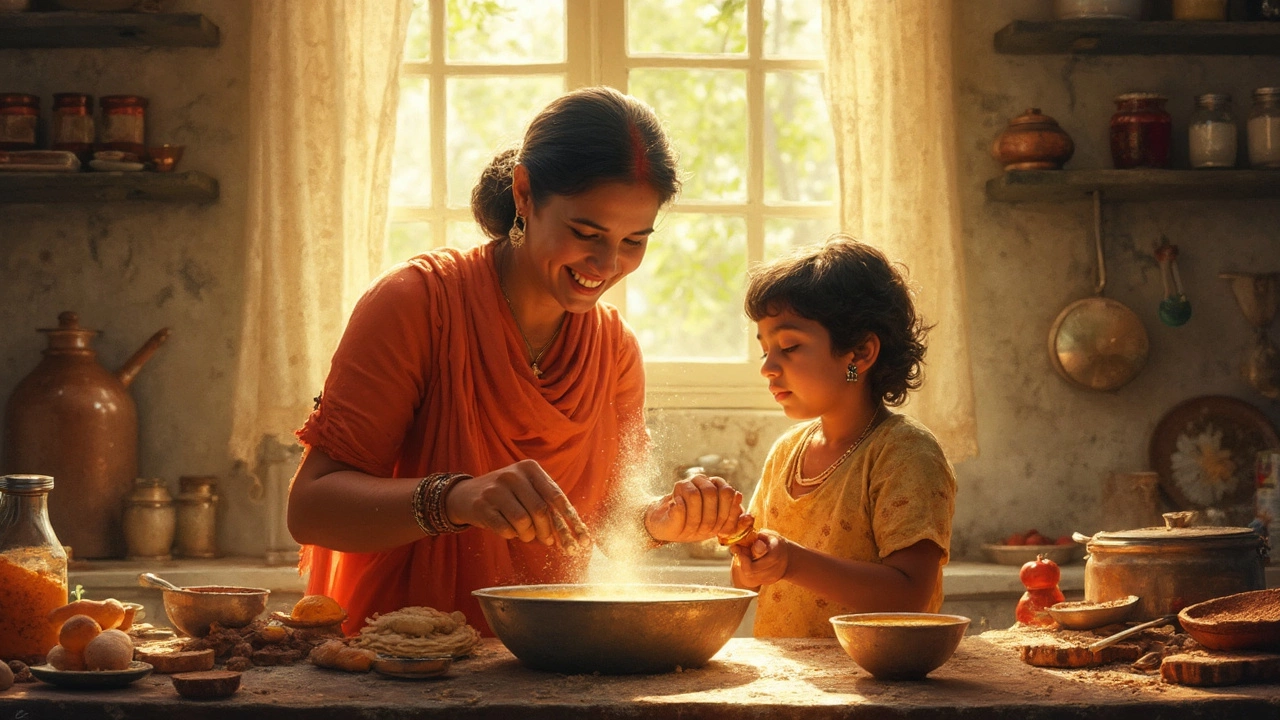Mastering Dosa Batter Fermentation Without Yeast
 Feb, 14 2025
Feb, 14 2025
Fermenting dosa batter without yeast might seem tricky, but once you get the hang of it, it's like having a secret superpower in the kitchen. It all starts with just a few basic ingredients—rice and urad dal. You wouldn't believe it, but these humble components are the stars of the show.
The key is getting the proportions right. Usually, a 3:1 or 4:1 ratio of rice to urad dal does the trick. Soak them separately for a few hours (usually about 6) before grinding. Here's a pro-tip: use a wet grinder if you have one. If not, a mixer works fine, just make sure the batter is smooth.
Now, let's talk about the magic of fermentation. You've got to give the batter enough warmth to let bacteria do their thing. Temperature is crucial. In warmer places, leaving it out overnight should be enough. If it's chilly, wrap the vessel in a thick fabric or put it in your oven with the light on. It's like creating a cozy little spa for your batter!
- Essential Ingredients
- The Fermentation Process
- Common Mistakes
- Weather And Its Impact
- Storing And Using the Batter
Essential Ingredients
When you're tackling the art of fermenting dosa batter without yeast, it all boils down to the right ingredients. Start simple with two main players: rice and urad dal. These are your bread and butter, or in this case, your dosa and chutney!
Choosing the Right Rice
Picking the right type of rice is like picking the perfect pair of shoes for a run. You want something that suits the purpose. Typically, South Indian short-grain rice or parboiled rice serves best for dosa. They soak well and grind to a fine consistency, essential for fermentation.
Urad Dal - The Underrated Hero
Urad dal, or black gram lentils, is the unsung hero of the batter. It's what gives your dosa that wonderful fluffy texture. Opt for whole urad dal with skin or split urad. Aim for fresh dal, as older stock might not ferment as well.
The Water Factor
Water might seem trivial, but its quality affects the batter's outcome. Use clean, filtered water to soak the ingredients and grind the batter. The less chlorine, the better your fermentation process will be.
The Salt Seasoning
While not a part of the initial soaking process, adding the right amount of salt after grinding is crucial. It not only enhances taste but also aids in fermentation. Use about a teaspoon per cup of rice for optimal results.
You might be thinking about optional add-ons like fenugreek seeds. These tiny seeds can boost fermentation and improve the texture. Soak a tablespoon of them with your dal, if you're up for a little experimentation.
The Fermentation Process
Getting the fermentation process just right is the secret sauce for perfect dosa batter. The transformation is quite magical, turning a simple mix of rice and urad dal into something that's light, airy, and full of flavor.
Temperature Control
The temperature is your best friend, or worst enemy, here. Ideally, you want a warm environment for your batter to ferment. At around 30°C (86°F), the naturally occurring bacteria in the dal starts to ferment, releasing those signature tangy flavors.
If you’re located in a cooler climate, try using an oven as an incubation space. Simply turn the light on to generate a bit of warmth, which creates the perfect setting for your batter to thrive. Or if it’s hot outside, the kitchen counter works just fine. Wrap the container in a cloth to maintain heat.
Consistency Check
Before setting it up for fermentation, check the batter's consistency. It should be thicker than pancake batter, but not a dough. Adjust with a little water if needed. This consistency ensures even fermentation.
Time Matters
Duration depends a lot on the surrounding temperature. In a warm environment, 8–10 hours should suffice. Cold weather might stretch this to 12-14 hours. Check the batter—it should have risen a bit, and the surface should be covered in tiny bubbles.
Troubleshooting
- No rise? Could be too cold or not enough time. Give it more hours at a stable warm temperature.
- Over-sour? It might have rested too long. Adjust timing on your next try.
Once you've nailed the basics of this fermentation process, you'll find delight in the simplicity and rewards of creating your own batch of dosas without any fuss.

Common Mistakes
Let's face it, fermentation can be a finicky business, and trying to ferment dosa batter without yeast isn't always smooth sailing. Mistakes happen, but knowing them ahead of time is half the battle. So, let's take a look at the common trip-ups that happen.
1. Incorrect Proportions
This one's big. Getting the ratio of rice to urad dal wrong is like trying to bake a cake with too much flour. Stick to a 3:1 or 4:1 ratio. Any other balance might result in a batter that's too thick or too runny, affecting the texture of your dosa.
2. Grinding Mishaps
Grinding is one of those steps that's easy to stumble on. Too coarse, and your batter won't ferment well. A mixer grinder can do the job, but if the paste isn't smooth, give it a bit more time. Many home cooks, like Anjali Mehta, say, "Patience during grinding ensures the perfect batter."
Anjali Mehta, Author of 'Indian Home Cooking'
3. The Salt Situation
When to add salt might seem like a minor thing, but it can impact fermentation. For optimal results, add salt just before you're ready to leave the batter to ferment. Too early, and you might hinder the bacteria necessary to work their magic.
4. Temperature Ignorance
Temperature often gets overlooked, but it's a huge deal. As trivial as it sounds, even a few degrees can make or break your fermentation process. In colder climates, using a warm light-bulb-lit oven is a neat hack to keep that batter cozy.
5. Poor Timing
The duration matters. Leave it too long, and you might end up with overly sour batter. Too short, and the batter will lack volume. It's a delicate balance, usually around 8 to 12 hours depending on your locale's climate.
Avoiding these common mistakes ensures you end up with that perfect dosa every time. It's a practice makes perfect deal with fermentation, but once you get it, you're golden.
Weather And Its Impact
Weather plays a huge role in how your dosa batter ferments. Believe it or not, the same recipe might not work the same way in different climates. Understanding this helps you avoid those batter fails.
Warm Weather
If you're living in a warm region, consider yourself lucky when it comes to fermenting dosa batter. The heat speeds up the process, often cutting the waiting time in half. It's like having a self-heating fermentation chamber! Leave the batter overnight at room temperature, and it should be good to go by morning.
Cold Weather
In colder climates, you need a bit more strategy. The cooler air slows down fermentation, which can be a bummer if you're craving dosas. To give nature a hand, try these tips:
- Place the batter in an oven with the light on (make sure the oven is off).
- Wrap the vessel with a thick cloth to retain heat.
- Set it on a warm surface, like near a stove or radiator.
No yeast means patience is your buddy here, so don't rush it!
Humidity's Role
Humidity also affects how fermentation happens. More humidity means faster action since moisture helps the process thrive. If your air is dry, you might notice fermentation taking a little longer.
Adjusting Ingredients
Don't be afraid to tweak things. If the weather's unpredictable, slightly increasing urad dal might help, as it has more beneficial bacteria. Another hack is adding a pinch of sugar as fuel for the natural fermentation process, giving it that little extra push.
Monitoring and Adjusting
Keep checking the batter's rise and texture. A good fermentation will double the batter and have a slightly tangy smell. If it's not working, give it more time or adjust its environment as needed.

Storing And Using the Batter
Once your dosa batter is perfectly fermented, storing it right is key to keeping it fresh and tasty. The great thing about dosa batter is that it can last for several days if you handle it right.
Refrigeration Tips
Keep the batter in an airtight container in the fridge. This slows down further fermentation and keeps the batter from turning too sour. Make sure to leave some space at the top of the container; the batter might expand a bit, so you don’t want a messy spill.
How Long Can You Store?
A properly stored dosa batter can last up to a week in the fridge. But here's the trick—noticing changes in color and smell can be a good indicator. If it looks or smells funky, it's time to toss it.
Making the Most of Leftover Batter
Sometimes, plans change, and you end up with more batter than you thought you'd use. No worries! You can mix in some chopped onions, grated carrots, or spices like black pepper and cumin seeds to turn them into delicious uttapams, a thicker version of dosa.
Freezing Excess Batter
If you're not going to use the batter within a week, consider freezing it. Dividing the batter into meal-sized portions before freezing can save you a lot of hassle later. When you're ready to make dosas, allow the batter to thaw naturally in the fridge overnight.
Remember, the magic of perfect fermentation means a little planning can go a long way. Having dosa batter ready makes it super easy to whip up a tasty, homemade breakfast or dinner anytime you want.